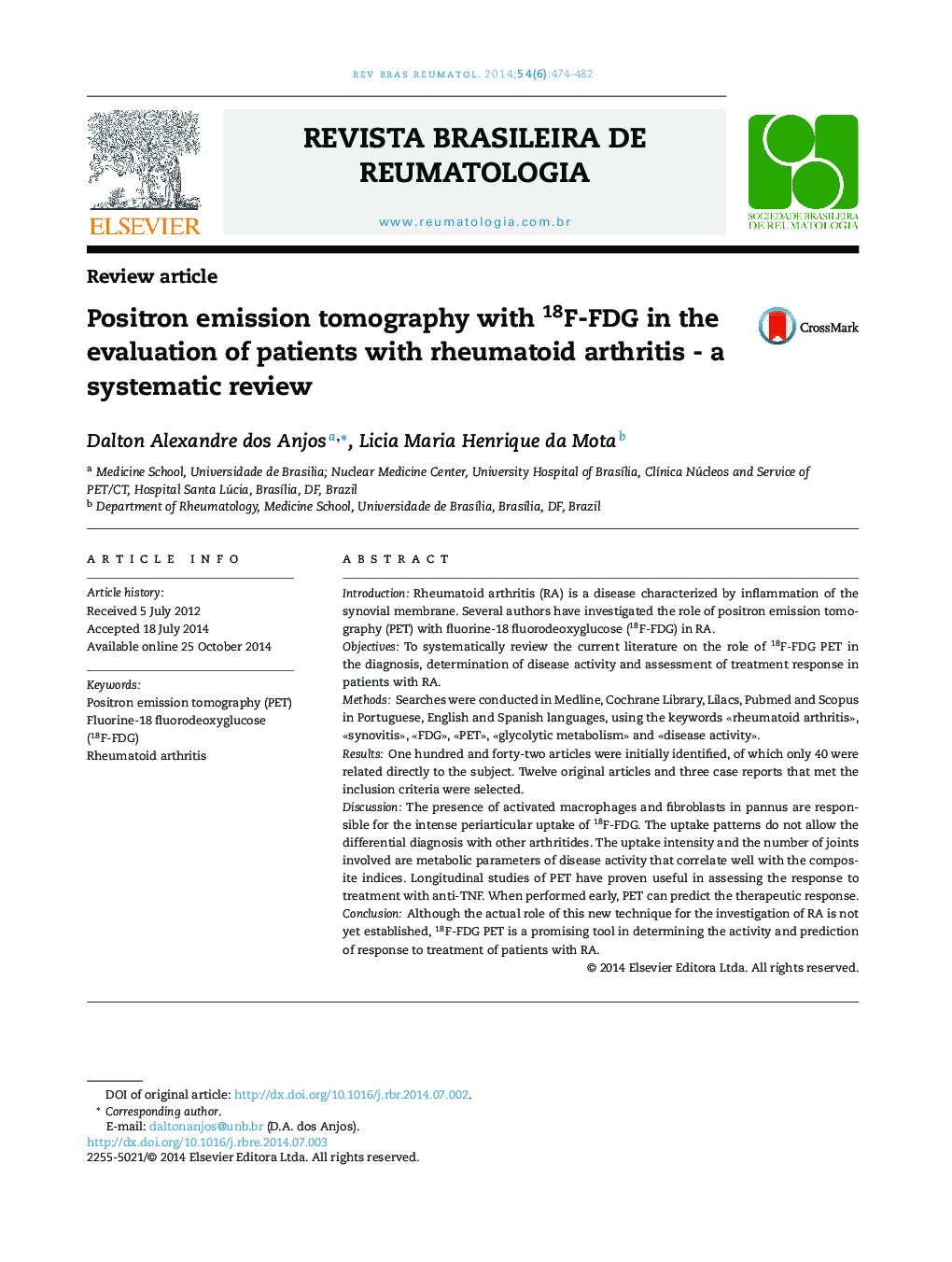| Article ID | Journal | Published Year | Pages | File Type |
|---|---|---|---|---|
| 3385119 | Revista Brasileira de Reumatologia (English Edition) | 2014 | 9 Pages |
IntroductionRheumatoid arthritis (RA) is a disease characterized by inflammation of the synovial membrane. Several authors have investigated the role of positron emission tomography (PET) with fluorine-18 fluorodeoxyglucose (18F-FDG) in RA.ObjectivesTo systematically review the current literature on the role of 18F-FDG PET in the diagnosis, determination of disease activity and assessment of treatment response in patients with RA.MethodsSearches were conducted in Medline, Cochrane Library, Lilacs, Pubmed and Scopus in Portuguese, English and Spanish languages, using the keywords «rheumatoid arthritis», «synovitis», «FDG», «PET», «glycolytic metabolism» and «disease activity».ResultsOne hundred and forty-two articles were initially identified, of which only 40 were related directly to the subject. Twelve original articles and three case reports that met the inclusion criteria were selected.DiscussionThe presence of activated macrophages and fibroblasts in pannus are responsible for the intense periarticular uptake of 18F-FDG. The uptake patterns do not allow the differential diagnosis with other arthritides. The uptake intensity and the number of joints involved are metabolic parameters of disease activity that correlate well with the composite indices. Longitudinal studies of PET have proven useful in assessing the response to treatment with anti-TNF. When performed early, PET can predict the therapeutic response.ConclusionAlthough the actual role of this new technique for the investigation of RA is not yet established, 18F-FDG PET is a promising tool in determining the activity and prediction of response to treatment of patients with RA.
ResumoIntroduçãoa artrite reumatoide (AR) é uma doença caracterizada pela inflamação da membrana sinovial. Diversos autores têm investigado o papel da tomografia por emissão de pósitrons (PET) com flúor-18 (FDG-18F) na AR.ObjetivosREVISÃO sistemática da literatura atual sobre o papel do PET com FDG-18F no diagnóstico, determinação da atividade da doença e avaliação da resposta ao tratamento em pacientes com AR.MétodosForam realizadas buscas nas bases de dados Medline, Biblioteca Cochrane, Lilacs, Pubmed e Scopus nos idiomas português, inglês e espanhol, utilizando as palavras-chave «artrite reumatoide», «sinovite», «FDG», «PET», «metabolismo glicolítico» e «atividade da doença».ResultadosCento e quarenta e dois artigos foram inicialmente identificados, dos quais apenas 40 relacionavam-se diretamente ao tema. Foram selecionados 12 artigos originais e três relatos de caso que preenchiam os critérios de inclusão.DiscussãoA presença de fibroblastos e macrófagos ativados no pannus é responsável pela intensa captação periarticular de FDG-18F. Os padrões de captação não permitem o diagnóstico diferencial com outras artrites. A intensidade de captação e o número de articulações envolvidas são parâmetros metabólicos de atividade da doença que apresentam boa correlação com os índices compostos. Estudos longitudinais de PET têm se mostrado úteis na avaliação da resposta ao tratamento com anti-TNF. Quando realizado precocemente, PET pode predizer a resposta terapêutica.ConclusãoEmbora o real papel dessa nova técnica na investigação da AR ainda não esteja estabelecido, PET com FDG-18F é uma ferramenta promissora na determinação da atividade e na predição de resposta ao tratamento de pacientes com AR.
